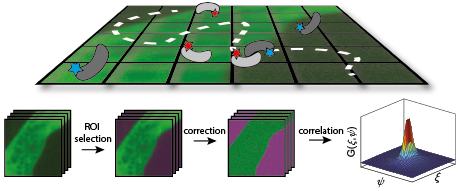Dynamics and interactions
The AOMC offers a collection of methods that allow the investigation of molecular and (sub-)cellular dynamics and interactions. These methods can be used to study how, when and where different proteins interact with each other, with other proteins and with the environment.


View the content of this page
Förster resonance energy transfer (FRET)
FRET allows to measure the distance between a donor and an acceptor fluorophore and can be used to study conformational changes of molecules as well as the interaction between multiple molecules. FRET experiments can be performed at the ensemble and single-molecule level.
time-correlated single photon counting (TCSPC) and fluorescence lifetime imaging microscopy (FLIM)
The fluorescence lifetime of a fluorophore is a key photophysical parameter that can be used to investigate the direct molecular environment of this fluorophore. FLIM is often employed to detect changes in FRET which in turn reports on changes in the distance between the donor and acceptor fluorophore.
fluorescence fluctuation spectroscopy (FFS)
A family of methods that allow quantifying molecular properties such as concentrations, mobility, stoichiometry, interaction affinities of diffusing molecules at equilibrium. The simplest implementation is fluorescence correlation spectroscopy (FCS), where fluorescence signals from freely diffusing molecules is recorded on a confocal microscope (without image scanning). The resulting time trace is analyzed via autocorrelation, which then informs on diffusion rates and concentration.

Illustration of FCS. Adapted from Schrimpf et al. 2018.
Image correlation spectroscopy extends FFS analysis to imaging data. With Raster ICS (RICS), for example, mobility and concentration information is obtained from confocal laser scanning microscopy images.

Illustration of RICS. Adapted from Schrimpf et al. 2018.
Arbitrary-region ICS (ARICS) even allows mapping molecular properties in e.g. a biological structure, providing detailed insights in the workings of complex biological machineries.

Illustration of ARICS. Adapted from Hendrix et al. 2016.
